Macrophytes are harvested regularly, deposited on adjacent dykes, and sometimes removed for composting in a nearby compost box. Resulting compost is fed to worms, which produce high value fertilizer plus protein for animal feed.
 Photo: Site operators harvesting macrophytes and depositing on dykes as fertilizer. White rectangle in center is a net for gathering. The key to efficiency is depositing macrophytes directly on dikes to reduce transport time and costs.
Photo: Site operators harvesting macrophytes and depositing on dykes as fertilizer. White rectangle in center is a net for gathering. The key to efficiency is depositing macrophytes directly on dikes to reduce transport time and costs.
Sludge which accumulates mostly in the first oxygenation basin is combined with waste cuttings from the site and macrophytes, then put into the compost box to produce compost. This sludge is not to be confused with sand which gathers at the sand trap near the facility entrance. Sludge goes through microbiological processes and converts to fertilizer, while sand has minimal fertilizer value.
It is also possible to shred site organic waste such as cuttings and macrophytes, then use these as a substrate for mushrooms. Each of these processes for solids also has the benefit of eliminating pathogens such as fecal coliforms and parasites. Ultimately, each process contributes greatly to the quality of soil fertility, and over time rebuilds poor soil into a productive, profitable base for agriculture.
